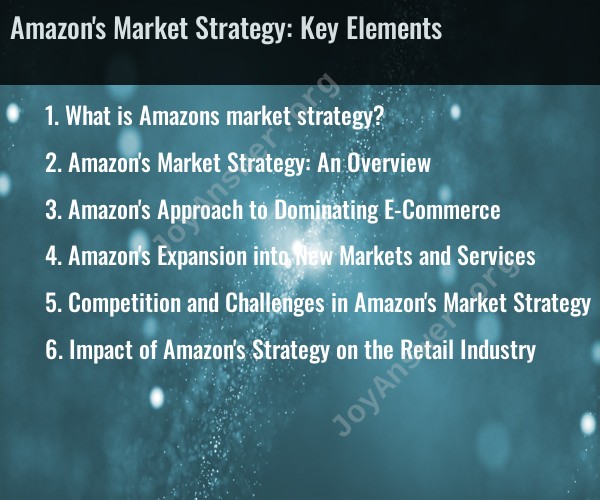What is Amazons market strategy?
Amazon's market strategy is characterized by several key elements that have contributed to its remarkable growth and dominance in the e-commerce and technology industries. Here are the main components of Amazon's market strategy:
Customer-Centric Approach: Amazon places a strong emphasis on customer satisfaction and strives to be the "Earth's Most Customer-Centric Company." This approach includes fast and reliable delivery, a wide selection of products, and exceptional customer service. Amazon collects and analyzes vast amounts of customer data to personalize recommendations and improve the shopping experience.
Prime Membership: Amazon Prime is a subscription service that offers various benefits, including free and fast shipping, access to Prime Video, Prime Music, and other services. Prime membership encourages customer loyalty and increased spending on the platform.
E-commerce Dominance: Amazon is one of the world's largest e-commerce platforms, offering a vast marketplace for both its own products and third-party sellers. Its user-friendly website and mobile app make it easy for customers to find and purchase products.
Marketplace for Third-Party Sellers: Amazon Marketplace allows independent sellers to list and sell their products on the platform. This creates a diverse and extensive product selection, driving more traffic to the site.
Logistics and Fulfillment: Amazon has invested heavily in its logistics and fulfillment infrastructure, enabling it to provide fast and reliable delivery services. Amazon's network of fulfillment centers, delivery drones, and delivery trucks ensures efficient order fulfillment.
Digital Services: In addition to e-commerce, Amazon offers a wide range of digital services, including Amazon Web Services (AWS) for cloud computing, Prime Video, Kindle e-readers, and the Amazon Echo with Alexa. These services further enhance its ecosystem and customer engagement.
Original Content Production: Amazon produces original movies and series for Prime Video, competing with other streaming platforms. This content contributes to customer retention and engagement.
Amazon Web Services (AWS): AWS is a leading cloud computing platform used by businesses worldwide. While it operates separately from the consumer-facing side of Amazon, AWS is a significant driver of Amazon's revenue and profit.
Data and Artificial Intelligence: Amazon's use of data and artificial intelligence (AI) helps personalize recommendations, optimize supply chain management, and improve customer experiences.
Acquisitions and Investments: Amazon has made strategic acquisitions, such as Whole Foods and Ring, to expand its presence in various industries, including groceries and home security.
Global Expansion: Amazon has a strong international presence, with operations in many countries. It tailors its strategy to suit local markets while maintaining a global brand.
Innovation and R&D: Amazon invests heavily in research and development, leading to innovative products and services. Initiatives like Amazon Go (cashierless stores) and Amazon Prime Air (delivery drones) showcase its commitment to innovation.
Sustainability and Environmental Initiatives: Amazon has committed to sustainability efforts, such as the Climate Pledge, with the goal of becoming net-zero carbon by 2040. This aligns with growing environmental concerns and consumer preferences.
Amazon's market strategy is dynamic and adaptable, driven by its commitment to customer satisfaction, innovation, and its willingness to invest in new ventures. This strategy has enabled Amazon to diversify and expand its reach into multiple industries while maintaining its position as a dominant force in e-commerce.
Amazon's Market Strategy: An Overview
Amazon's market strategy has been remarkably successful, transforming the retail landscape and establishing the company as a global e-commerce giant. Its strategy revolves around several key principles:
Customer obsession: Amazon prioritizes customer satisfaction, offering a vast selection of products, competitive pricing, fast and reliable delivery, and excellent customer service.
Low prices and convenience: Amazon's pricing strategy is focused on offering low prices and convenient shopping experiences, making it an attractive choice for consumers.
Diversification and innovation: Amazon has continuously expanded its product offerings beyond books, venturing into electronics, apparel, groceries, and even cloud computing services.
Data-driven decision-making: Amazon leverages vast amounts of customer data to personalize product recommendations, optimize pricing, and enhance customer experiences.
Investment in infrastructure: Amazon has invested heavily in logistics and infrastructure, building a vast network of warehouses, fulfillment centers, and delivery services to support its global operations.
Amazon's Approach to Dominating E-Commerce
Amazon's dominance in e-commerce stems from its effective execution of its market strategy, including:
Third-party seller marketplace: Amazon's marketplace platform allows third-party sellers to list and sell their products, expanding its product selection and increasing its reach.
Amazon Prime membership: Amazon Prime offers a subscription service that provides members with free two-day shipping, exclusive deals, and access to streaming services, increasing customer loyalty and revenue.
Fulfillment by Amazon (FBA): Amazon's FBA program allows sellers to store and ship their products through Amazon's fulfillment centers, reducing their logistics costs and improving delivery speeds.
Amazon Web Services (AWS): Amazon's cloud computing platform, AWS, has become a major source of revenue and has expanded Amazon's reach into the technology industry.
Acquisition strategy: Amazon has acquired several companies to expand its product offerings, such as Whole Foods Market for groceries and Twitch for gaming.
Amazon's Expansion into New Markets and Services
Amazon has consistently expanded into new markets and services, demonstrating its willingness to innovate and adapt to changing consumer trends. These expansions include:
Amazon Fresh and Whole Foods Market: Amazon's entry into grocery delivery and physical grocery stores with Whole Foods Market has expanded its reach into the grocery industry.
Amazon Alexa and Echo devices: Amazon's smart home products, such as Alexa-enabled Echo devices, have expanded its presence in the technology industry and the home automation market.
Amazon Studios and Prime Video: Amazon's investment in original content production and its Prime Video streaming service has expanded its presence in the entertainment industry.
Amazon Care: Amazon's foray into healthcare with Amazon Care, a virtual healthcare service, demonstrates its willingness to venture into new areas.
Competition and Challenges in Amazon's Market Strategy
Despite its dominance, Amazon faces competition from other e-commerce giants like Walmart, Alibaba, and eBay. These companies are also expanding their product offerings and investing in technology and logistics to compete effectively.
Additionally, Amazon faces challenges such as:
Regulatory scrutiny: Amazon's size and market power have drawn increased scrutiny from antitrust regulators, raising concerns about its impact on competition and consumer welfare.
Labor issues: Amazon has faced criticism for its labor practices, including warehouse working conditions and unionization efforts among its employees.
Counterfeit products: Amazon has been criticized for the presence of counterfeit products on its marketplace, which can damage customer trust and lead to legal challenges.
Impact of Amazon's Strategy on the Retail Industry
Amazon's market strategy has had a profound impact on the retail industry:
Shift to e-commerce: Amazon has accelerated the shift from traditional brick-and-mortar retail to e-commerce, forcing many traditional retailers to adapt their strategies and invest in online platforms.
Increased competition and consolidation: Amazon's dominance has intensified competition in the retail industry, leading to consolidation among smaller retailers and the closure of many physical stores.
Changes in consumer behavior: Amazon has influenced consumer behavior, making consumers more accustomed to online shopping, free shipping, and fast delivery expectations.
Data-driven retailing: Amazon's use of data has transformed retailing, with many retailers adopting data-driven approaches to pricing, marketing, and customer engagement.
Overall, Amazon's market strategy has revolutionized the retail industry, setting the standard for e-commerce and influencing consumer behavior. The company's continued innovation and expansion will likely shape the future of retail for years to come.













